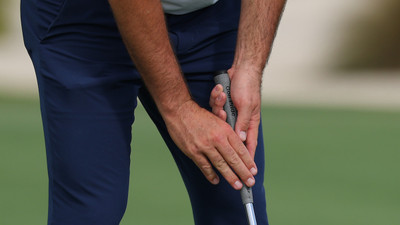Five Unorthodox Putting Grips You Need To Try
Posted by GolfBox on 8th May 2025
To lower your score, you really need to start pouring in those putts. But what should you do when your putter is so cold it makes an Antarctic winter seem mild? Easy. You shake things up and try a fresh new putting style. Give these five unconventional putting grips a crack and you never know, one of them might click and stick.
1. LEAD HAND LOW
This one is exactly as it sounds: the lead hand sits below the trail hand on the putter grip. Also known as the cross-hand grip, the Lead Hand Low grip levels up your shoulders at address to promote a path that moves straight down the target line while also setting up a bit of forward shaft lean to help your lead shoulder drive the stroke. The grip also prevents the dominant top hand from exerting too much influence during the putting stroke, which encourages better face control.
You’ll need: a putter!
2. THE CLAW
The claw is arguably the most unconventional-looking putting grip. The trail hand is low and attaches to the putter in the form of a crab claw or pincer, with the index finger and thumb cradling the grip. The theory behind the claw grip is that the pincer shape takes the dominant hand out of play, reducing its influence on the stroke; rather than powering the stroke, it becomes more of a guide. Thus, the claw grip encourages the shoulders in be in command of the putting stroke and eliminates a handsy or wristy action.
You’ll need: a pistol grip
3. BROOMSTICK
Once viewed with suspicion as a crutch for chronic yippers, the broomstick method has shed its stigma to become a mainstream option. While you can no longer anchor the broomstick against your chest like you used to, the long-shafted broomstick putter forces golfers to rock their shoulders rather than use their hands during a putting stroke. It does take some time to master the specific style of stroke required to operate a broomstick but its inherent pendulum motion will lead to a more consistent roll.
You’ll need: a broomstick putter
4. THE PRAYER
Seeking divine intervention in your quest to make more putts? The prayer grip could be your answer. The prayer grip sees your palms face each other on opposite sides of the grip, with the thumbs connecting in the middle — much like you would if you were striking a prayerful pose with your hands. The prayer grip creates a triangle between the shoulders and arms and sets the shoulders level at address, a position that will encourage a pendulum-like stroke, and helps you swing the putter with your body rather than hands. And the neutral position of the palms when attached to the putter means neither hand tends to dominate; it should feel as if you are squeezing the putter between your palms rather than gripping it.
You’ll need: a wide grip
5. ARM LOCK
To use the Arm Lock method, you’ll first need a specialised Arm Lock putter. Featuring extra loft and a longer shaft, Arm Lock putters are designed to sit flush with your lead forearm. It’s the only way to legally anchor a putter and with arm and putter locked in step, it prevents golfers from getting wristy and leads to a more repeatable and consistent putting stroke.
You’ll need: an armlock putter

